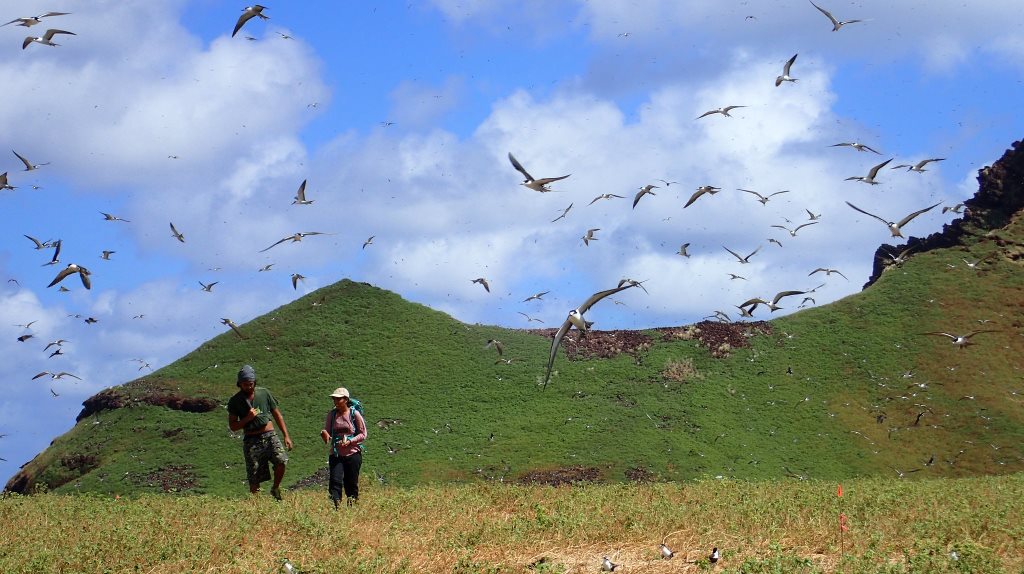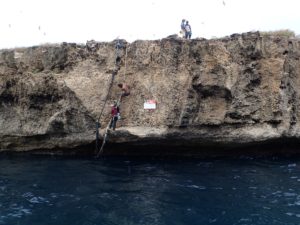The future is looking a little brighter for seabirds on the island of Teuaua in French Polynesia, following the first successful removal of human-introduced invasive rats on an island in the Marquesas Archipelago.
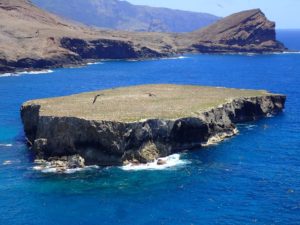 The project, implemented by the Societe d’Ornithologie de Polynesie(SOP), Island Conservation, BirdLife International and Association Vaiku’a i te manu o Ua, will protect and help restore a nationally-significant population of 90,000 Sooty Terns.
The project, implemented by the Societe d’Ornithologie de Polynesie(SOP), Island Conservation, BirdLife International and Association Vaiku’a i te manu o Ua, will protect and help restore a nationally-significant population of 90,000 Sooty Terns.
Invasive rats present on the island devoured countless seabird eggs, chicks and native plants. Free from invasive rats, seabirds can once again safely nest, and the native plants can grow tall and thrive.
Societe d’Ornithologie de Polynesie – Manu (English: The Polynesian Ornithological Society) a.k.a. “Manu”, which means “bird” in Tahitian language, is working for the protection of wild birds of Tahiti and her Islands as well as for the preservation of their habitats. A group of enthusiastic amateurs of French Polynesian birds founded this non-governmental and non-profit association in July 1990.
SOP Manu project manager Tehani Withers explained, “Both islands are critical habitat for breeding and roosting seabirds and offer a glimpse into the once rich coastal ecosystems that existed across the Marquesas archipelago.”
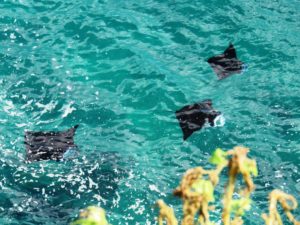 Seabirds, often referred to as “ecosystem engineers”, are critical to a healthy functioning ecosystem. They boost the fertility of island soils by relocating marine nutrients to terrestrial environments by depositing guano.
Seabirds, often referred to as “ecosystem engineers”, are critical to a healthy functioning ecosystem. They boost the fertility of island soils by relocating marine nutrients to terrestrial environments by depositing guano.
These nutrients run-off into the marine ecosystem via natural weathering processes, enriching the surrounding waters, increasing coral productivity and the growth and abundance of local fish populations.
BirdLife International Pacific Seabird Programme Manager Pacific Steve Cranwell said, “We are optimistic seabirds once present on the island may return, increasing the diversity of the island’s seabird community and security of threatened species like the Polynesian Storm-petrel.”
Teuaua Island Conservation restoration specialist Jason Zito added, “Teuaua demonstrates that removal of invasive rats is possible in the Marquesas. It is seen as an important stepping stone to much larger, more complex restoration projects such as Hatuta’a and Mohotani. Restoration of these islands would improve the fortune of four endangered terrestrial bird species and two endangered seabird species that call the Marquesas home.”
Despite being small in size, Teuaua was a logistically complex project. As Zito describes, “transporting people, supplies, and equipment onto the island involved leaping off a moving boat and clambering up a rope onto a 1-meter wide rock ledge followed by a climb up a 10-meter vertical cliff to the island’s plateau. Once on the island’s plateau, there is no respite from the elements and the 10,000’s of dive bombing and screeching Sooty Terns make it hard to hear yourself think.”
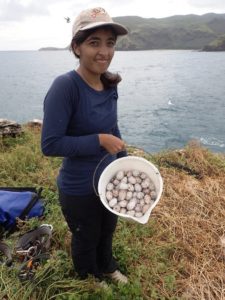 Teuaua is important culturally to the people of Ua Huka. Sooty Tern (Kaveka in the Marquesan language) eggs from the island are harvested once or twice a year when the Uru (breadfruit tree) are fruiting.
Teuaua is important culturally to the people of Ua Huka. Sooty Tern (Kaveka in the Marquesan language) eggs from the island are harvested once or twice a year when the Uru (breadfruit tree) are fruiting.
This practice is losing popularity as younger generations become more dependent on imported food. However, knowing that they have this resource in case of supply shortages is important to the local population and Sooty Tern egg harvesting is part of their cultural heritage.
The goal of the project was to restore habitat for native seabirds and plants by removing invasive rats from the island, build confidence and capacity within the local community in the field of invasive species management, and provide greater protection for the nearby island of Hemeni, an important refuge for seabird populations.
With Teuaua now free of rats, the project partnership can now focus on planning the restoration of the six other uninhabited islands within the Marquesan Archipelago. To do this they first need to find the estimated $3M USD required to implement the project that will require a support ship and helicopter.
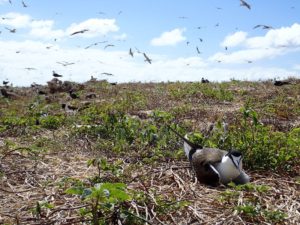 Island Conservation is the only global, not-for-profit conservation organization whose mission is to prevent extinctions by removing invasive species from islands.
Island Conservation is the only global, not-for-profit conservation organization whose mission is to prevent extinctions by removing invasive species from islands.
They work where the concentration of both biodiversity and species extinction is greatest: islands. Removing a primary threat—introduced invasive vertebrates—is one of the most critical interventions for saving threatened plants and animals and restoring island ecosystems.
Once invasive species are removed, native island species and ecosystems can recover, often with little additional intervention. Since 1994, IC and partners have successfully restored 63 islands worldwide, benefiting 1173 populations of 468 species and subspecies. IC is headquartered in Santa Cruz, California, with field offices in Australia, the Bahamas, British Columbia, Chile, Ecuador, Hawai’i, New Zealand, Palau, and Puerto Rico.
All photos courtesy of Island Conservation.

